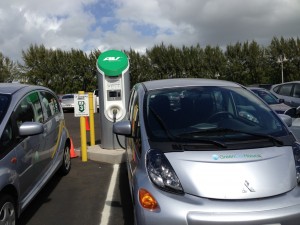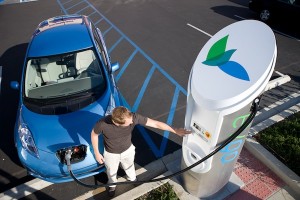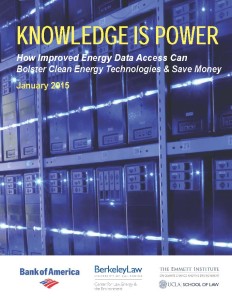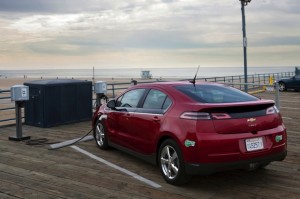From Business Green’s summary of BCC Research:
The global market for electric vehicle power sources is set to rise to around $21bn by 2019, a new analysis has predicted. In 2013 the market stood at more than $11.9bn, but it is now expected to expand at a compound annual growth rate (CAGR) of more than 11 per cent between 2014 and 2019, according to BCC Research.
The company says the expected growth is a combination of electric vehicle (EV) use becoming more widely established and well-financed private and government-backed plans to introduce large numbers of the vehicles to urban streets.
The predictions follow recent evidence that sales are electric cars and vans are starting to gain momentum. For example, in the UK electric car sales quadrupled over 2014.
The big growth is expected from electric bikes and scooters in East Asia, which use lead acid batteries. It’s a solid reminder that electrification covers not just traditional cars and trucks. The U.S. would certainly benefit from diversifying our electric mobility to include these lower-cost options. And for countries like China, hopefully the electrification movement will spread to the passenger vehicle sector like it has in states like California and Georgia and countries like Norway.
Green Car Reports looked into it, and the numbers aren’t pretty. From a recent study of charging station hosts in North Carolina:
Host sites were responsible for both installation and operating costs, and electric-car drivers could charge for free.
The charging stations themselves were also provided free, but applicants still had to pay $20,000 to $60,000 to install them. That was cited as one of the reasons why–out of a pool of 16 applicants–only five sites ended up installing the fast-charging sites.
One factor that boosts costs for DC fast charging–as well as 240-Volt AC Level 2 charging–is digging a trench or otherwise connecting stations to a power source. In addition, DC fast charging comes with far higher power requirements–sometimes enough to trigger demand fees from utility companies.

Fast charger at the Kauai Hyatt — paid for with stimulus money but installed and operated by the hotel
Meanwhile, the revenue from these sites is typically not sufficient to cover costs. For example, the ideally located San Juan Capistrano fast-charging station between Los Angeles and San Diego only netted $10,000 in revenue over 18 months, with a $10-15 fee per hour of charging. That amount is not enough to cover operating costs, let alone pay back the cost of installation.
Perhaps site hosts with a retail shop can make up for it, as customers waiting to charge buy coffee or snacks like at a gas station convenience store. But you’d have to sell a lot of big gulps to break even.
To me, all of this adds up to the need for a serious look at having utilities enter the charging market, as California regulators are considering. Because otherwise, the numbers just aren’t there to encourage charging infrastructure at the scale we need.
 Good news for those who can’t afford a Tesla but want to or currently drive a battery electric:
Good news for those who can’t afford a Tesla but want to or currently drive a battery electric:
The [charging] stations will be built and operated by ChargePoint, the nation’s largest charging provider, which already has about 20,000 stations in place. Prices vary, but about $.50 per kilowatt-hour is standard, which means “filling” the e-Golf will run you 12 bucks if you’ve managed to completely drain the 24 kwHr pack.
In the east, the network will let drivers go from Boston to Washington on I-95. Out west, you’ll be able to drive from Portland, Oregon, to San Diego. The stations will offer 50-kW fast chargers, which can get most EVs up to 80 percent charge in 30 minutes, and slower 24-kW Level 2 stations.
It’s great to see the automakers collaborating like this, and the charging stations will be open to any compatible EV car (unlike Tesla’s network, which only works on Tesla batteries). It’s also badly needed given the slow pace of infrastructure deployment here in California. EVgo is using state settlement money from the “rolling blackouts” of the turn-of-the-century, but the charger rollout is slow and mostly focused within urban areas, as opposed to between them. So we need those fast chargers on key highways between major cities, or else all-battery EVs of the 80-mile range variety are basically stuck as commuter cars.
 California is poised for a major energy transformation in the coming decades, with Governor Brown pledging to put the state on a path to 50% renewables and 50% less petroleum usage by 2030. Achieving this transformation will require a robust and thriving clean technology sector, including renewable energy and energy storage developers, energy efficiency contractors, smart grid hardware and software purveyors, and electric vehicle automakers, among others.
California is poised for a major energy transformation in the coming decades, with Governor Brown pledging to put the state on a path to 50% renewables and 50% less petroleum usage by 2030. Achieving this transformation will require a robust and thriving clean technology sector, including renewable energy and energy storage developers, energy efficiency contractors, smart grid hardware and software purveyors, and electric vehicle automakers, among others.
But to ensure the success of these industries, as well as a cost-effective energy transition for consumers, California must expand access to energy information. This information ranges from customer access to their long-term usage patterns in an easily-readable, standardized format, to utility statistics on distribution grid needs and pricing, to anonymized, aggregated energy usage patterns on a neighborhood scale. Customers can harness this information to use energy more efficiently, while clean technology companies can use it to improve their services, customer acquisition efforts, and competitiveness with traditional energy providers. Policy makers and nonprofit advocates could also use this information to target energy incentives to the customer groups and regions that would make the best use of them — thereby deploying limited public funds more cost-effectively.
To offer solutions for improved access to energy information, UC Berkeley and UCLA Schools of Law are today releasing the report Knowledge is Power: How Improved Energy Data Access Can Bolster Clean Energy Technologies & Save Money. The report resulted from a one-day gathering of clean technology leaders (including renewable energy developers, battery experts, smart grid suppliers, energy efficiency contractors, and electric vehicle automakers) and public officials. It is the fourteenth in the law schools’ Climate Change and Business Research Initiative, sponsored by Bank of America, which develops policies that help businesses prosper in an era of climate change.
The group identified barriers to expanded information access, from a lack of incentives and funding for utilities to collect and share data to concerns about compromising customer privacy and cybersecurity breaches. The report identifies information that would be most valuable to the clean technology sector and recommends that policy makers:
- Establish customers’ right to improved access to their own usage information through an easily organized, standardized format, including the disclosure of historic building energy audits;
- Develop cost-recovery mechanisms for utilities to collect and share aggregated, anonymized energy and market statistics to researchers and the private sector; and
- Fund the development and maintenance of secure energy information centers.
Most of these and other recommendations in the report will require action from state legislators and regulators, including via existing regulatory efforts at both the California Public Utilities Commission and California Energy Commission. Ultimately, by implementing steps like these, California can ensure a smoother and more cost-effective transition to a clean, efficient, and localized energy and transportation system.
A Tesla driver recorded his friends’ reactions while accelerating from a stop in his new P85D model:
Make sure to watch to the end.
 Among electric vehicle aficionados, the Chevy Volt is sort of a black sheep of the bunch. The car was one of the original “Big 3” of the electric vehicle market, along with the Nissan LEAF and Tesla Model S. But unlike those two cars, which represented opposite ends of the price and range spectrum for an all-battery vehicle, the Chevy Volt tried to be an all-in-one consumer car. For about $34,000 (without incentives), it features a 38-mile all-electric battery range. And then a gas engine kicks in to give you the full range of an internal combustion engine car.
Among electric vehicle aficionados, the Chevy Volt is sort of a black sheep of the bunch. The car was one of the original “Big 3” of the electric vehicle market, along with the Nissan LEAF and Tesla Model S. But unlike those two cars, which represented opposite ends of the price and range spectrum for an all-battery vehicle, the Chevy Volt tried to be an all-in-one consumer car. For about $34,000 (without incentives), it features a 38-mile all-electric battery range. And then a gas engine kicks in to give you the full range of an internal combustion engine car.
But the Volt has some obvious limitations. First is the 38-mile battery range. After that, the gas engine requires more expensive premium gas. And some customers complained about the lack of room in the back seat, with two adults fitting uncomfortably (whereas I can fit two carseats and a booster in the backseat of my LEAF). Perhaps as a result, sales have fallen in the last two years, as Inside EVs reports:
For full year 2014, 18,805cars were been sold – which is down 18.6% from 2013 when GM moved 20,702 Volts. This means that the Volt is the first electric vehicle to post two consecutive years of falling sales in America.
Some analysts believe the drop-off was in part due to customer awareness that Chevy was about to introduce a new version of the Volt this year. And that just happened:
The big news — other than the sleeker, all-new design — is that electric-only range has increased about a dozen miles to 50. At that point, a gas engine kicks in, offering a total range of “more than” 400 miles before a fill-up and recharge are necessary. The engine is all-new, a 1.5-liter unit that takes regular gas and delivers a combined fuel economy of 41 mpg when in use. Charging comes in 4.5 hours connected to a 240-volt source.
Yet if I had to guess, I think the Volt’s electric/gas combo presents a fundamental consumer challenge that will be hard to overcome. And it’s a problem for virtually any plug-in electric that also has a gas engine. In my view, with the electric/gas combo, you get the worst of both worlds without inspiring passion among any consumer group. The battery range isn’t enough to get drivers gas-free, a major shortcoming if you’re motivated by either environmental concerns or a desire for the superior driving experience of going electric. And the gas part of the car is expensive (premium fuel) and negates the low-maintenance advantage of an all-electric: you still need the extra thousand moving parts for an internal combustion engine, with all the sparkplugs and oil changes and transmissions to worry about.
I think most drivers want either all-electric or nothing. The extra range with a gas engine isn’t that necessary for most trips. An 85-mile range in a cheap all-battery car covers 95% of trips. You’re almost better off renting a cheap car for those few long-distance trips a year, rather than sticking a gas engine in your battery EV. The Volt is certainly a good car for those who only want one all-purpose car and really need the extra range from the gas engine — basically long-distance commuters. But I don’t think this plug-in/gas model is really viable in the long run, particularly as batteries improve in price and performance.
Perhaps that’s why Chevy is now working on the “Bolt” — an all-electric, $30,000, 200 mile range EV to compete with Tesla’s hyped up Model 3, due supposedly in 2017. It’s great to see the automakers competing for this coveted breakthrough in EV technology. And once the Bolt is out, I will definitely consider a Chevy EV. But not so much with the Volt.
With a name straight out of a WALL-E future, it’s ARPA-E, also known as the “U.S. Advanced Research Projects Agency – Energy” (don’t confuse them with DARPA-E, its cousin that focuses on defense).
Why is ARPA-E so important? Because this Department of Energy group is searching out and funding those moonshot — or sunshot — technologies that will give us the energy breakthroughs we need to fight climate change. If we’re going to find the better battery to finally wean us off oil and into electric drives, or build the cheap energy storage device to capture surplus renewables and truly decarbonize the grid, or make our solar panels even more efficient and cheap, chances are ARPA-E will be involved in making that happen. From its website:
Since 2009, ARPA-E has funded over 360 potentially transformational energy technology projects. Many of these projects have already demonstrated early indicators of technical success. For example, ARPA-E awardees have:
- Developed a 1 megawatt silicon carbide transistor the size of a fingernail
- Engineered microbes that use hydrogen and carbon dioxide to make liquid transportation fuel
- Pioneered a near-isothermal compressed air energy storage system
Technical achievements like these have spurred millions of dollars in follow-on private-sector funding to a number of ARPA-E projects. In addition, many ARPA-E awardees have formed start-up or spin-off companies or partnered with other parts of the government and industry to advance their technologies.
If I were in charge of the federal budget, I would fund this agency to the brim. So I’m pleased to see ARPA-E announcing another round of funding, this time for $125 million for “renewable and non-renewable electricity generation, transmission, storage and distribution, as well as energy efficiency technologies.” The funds can also go to transportation-oriented projects, including those focused on fuels, electrification, and energy efficiency. You can read more here.
While I know it’s a huge stretch to imagine happening, I hope this new congress supports the agency in the budget process. It just may be the best hope we have for finding and developing the technologies needed to truly solve climate change.
After Tuesday’s groundbreaking, Eric Holthaus of Mother Jones now decides high speed rail isn’t worth it anymore:
That $68 billion California plans to spend on its high-speed rail system could buy 82,000 state-of-the-art electric buses, 55 times Greyhound’s entire nationwide fleet. And they could start operating immediately. Dedicated bus lanes and congestion pricing have done wonders for reducing commute-hell in many cities, like London. There are ways to make intercity bus travel more appealing, too, as evidenced by the expansion of carriers like wifi-enabled MegaBus in recent years. Similar “curbside” buses are the fastest growing mode of intercity transport and are the most carbon-friendly way to travel medium to long distances in the United States.
He also recommends funding self-driving cars and regulating airplane emissions. He’s motivated by the urgency of climate change:
Given the incredible pressure that global warming is inflicting, we can’t waste precious resources on high-speed rail. It’s impractical to hope that truly high-speed rail—the kind that will compete with air travel—will arrive in time to do much good.
 I appreciate Holthaus’s concern for time running out on the Earth’s climate and his willingness to search for low-cost, immediate transportation solutions. But his piece is misguided in slamming the decision to go forth with high speed rail.
I appreciate Holthaus’s concern for time running out on the Earth’s climate and his willingness to search for low-cost, immediate transportation solutions. But his piece is misguided in slamming the decision to go forth with high speed rail.
First, these aren’t “limited public transportation” funds that are being used. They are funds that were raised and dedicated solely for high speed rail. California voters in 2008 didn’t vote on a $10 billion bond initiative for 82,000 electric buses — they voted for high speed rail. Based on that political will, politicians in Washington specifically set aside stimulus funds for high speed rail (as well as electric vehicles) to help fund the system. And state politicians followed suit with cap-and-trade funds.
We can debate the wisdom of the voters and our leaders, but there’s no doubt that high speed rail is what they wanted, and they raised the funds to make it happen. In other words, high speed rail attracted its own constituency that found the funds for it. It’s not politically or legally feasible at this point to redirect those monies to other transportation forms, as Holthaus desires.
Second, there’s no reason why we can’t do what Holthaus recommends and still go forward with high speed rail. High speed rail doesn’t stop congestion pricing from happening, or more bus-only lanes, or regulation of airlines. California has an aggressive set of policies to encourage more electric vehicles, including buses. True, the cap-and-trade money that goes to high speed rail could have been used for other things. But it’s a relatively small amount of money, and a majority of those dollars go to other important greenhouse gas-reducing options. Even the stimulus, which is helping to support high speed rail, is also funding huge advancements in battery technology — which is critical for deploying more electric buses, cars, and grid storage.
Finally, Holthaus doesn’t engage with the potential greenhouse gas upsides for high speed rail. Most significantly, the system will divert the most polluting airplane trips as well as car traffic for a growing population that is already hemmed in by congestion and crowded airports. It will also entail a large investment in renewable energy to power the trains. Perhaps even more importantly, high speed rail could stimulate much more transit-oriented development in the Central Valley, which is otherwise susceptible to the same sprawl over its flat, agricultural-rich landscape that paved over the Los Angeles basin. The benefits of reducing per capita vehicle miles traveled in the Central Valley by providing an organizing infrastructure for more pedestrian and transit-friendly growth could be immense.
So while I’m sympathetic to the sentiment behind Holthaus’s arguments, I don’t think it’s fair to come out now and slam high speed rail. It’s going to happen, the money is there for it at this point, and we need to be thinking about a range of solutions to limit transportation emissions and not pit one technology against others. High speed rail is one important piece of the puzzle, and we should focus our efforts on making sure it gets built as efficiently for the taxpayers and climate as possible.
Maybe one of the best parts about 2015 will be being one-step closer to a mass market, 200-mile range electric vehicle. At an Autoline panel of experts (video below), two battery business leaders (Ann Marie Sastry, CEO of Sakti3 and Prabhakar Patil, CEO of LG Chem’s North American unit), and a researcher (Brett Smith of the Center for Automotive Research) hint that we may be two years away from such a transformative vehicle.
The key is to get the cost down to $100 per kilowatt hour, which Sastry is pledging to achieve at her company by 2017. Meanwhile, if Tesla can get there with the Gigafactory, the panelists predict the company will have competition from other automakers. Which is only a good thing for consumers and fans of keeping the Earth’s climate at a livable temperature. If you don’t have time to watch the video, Green Car Reports has a write-up of the video here.
Here’s my take on the biggest environmental victories in 2014:
5. Continuing strength of the electric vehicle market. Sales are going well, new models are being introduced, and automakers are on notice that this trend isn’t going away. No technology is more important for reducing our greenhouse gas emissions than electric drives, so let’s hope the progress continues.
4. Transportation fuels stay under California’s cap-and-trade program. There was some debate about whether or not fuels would stay under the cap, given oil-and-gas industry machinations and legislative action. But the California Legislature stayed strong. Including fuels under the cap will mean more auction revenue for climate-fighting strategies and a statement that gas prices should include at least some of the cost of pollution. Nationally, it means California is showing how to make a cap-and-trade program work without hurting the economy, providing a model for other states and one day the nation.
3. EPA’s clean power rule. It was long overdue and probably too weak, but the Obama Administration developed a power sector rule that gives states flexibility to innovate in how they reduce emissions from power plants. That can include more renewables but also more energy efficiency (of course, all this assumes the plan doesn’t get gutted in the courts). As states respond, the price of renewables will decrease and states can start to share markets to make further reductions.
2. Continued solar energy boom. Prices of panels are falling, the efficiency is increasing, and solar is now becoming cost-competitive with fossil fuels in some areas. This technology is a crucial part of the solution to decarbonize the electricity supply and enable electrified transportation.
1. Climate agreement with China. While the specifics of the deal were very weak, it’s a major symbolic and psychological victory that can be improved over time. China is the major emitter of carbon in the world, and they have now committed themselves to reducing these emissions. That sets up Paris in 2015 for a potentially meaningful international agreement and also bolsters arguments to reduce emissions here in the United States.
Honorable mention: the advent of cost-effective, viable energy storage deployment in California.
Happy New Year! Let’s hope 2015 brings even more progress as we race against time on climate change.


